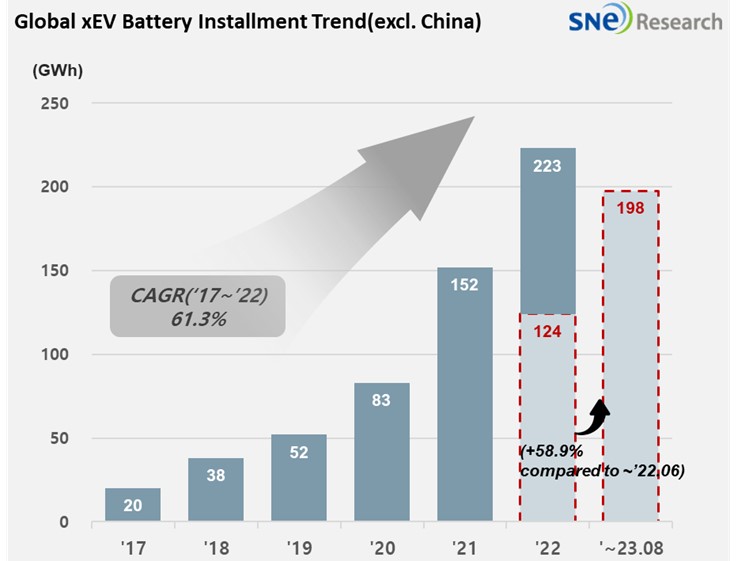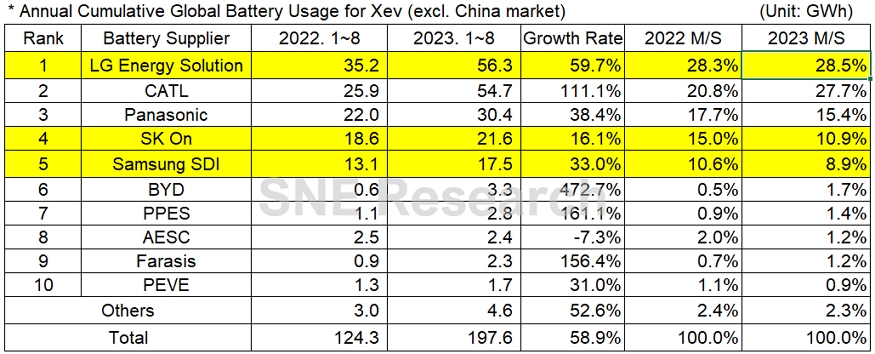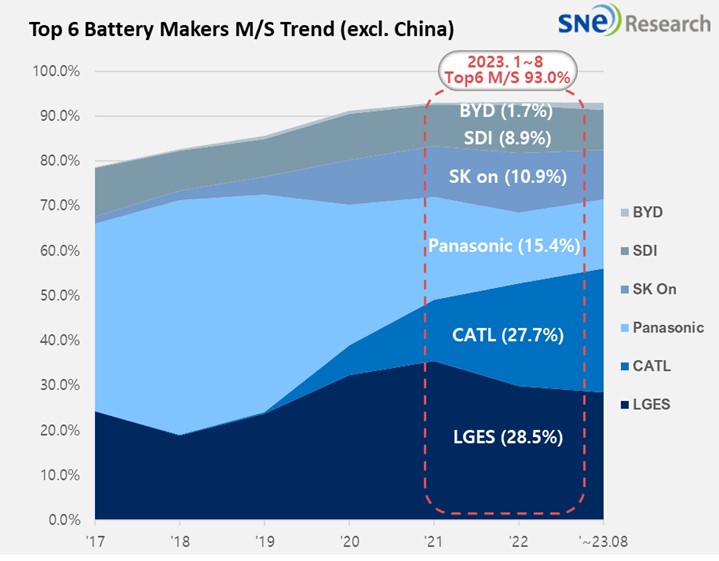From Jan to August in 2023, Non-Chinese Global[1] EV Battery Usage[2] Posted 197.6GWh, a 58.9% YoY Growth
- K-trio took up 48.3% M/S, with LGES remaining on top.
Battery installation for
global electric vehicles (EV, PHEV, HEV) excluding the Chinese market sold from
January to August 2023 was approximately 197.6GWh,
a 58.9% YoY growth.


The combined
shares of K-trio recorded 48.3%, a 5.6%p decline
from the same period of last year, but their battery usage was still in an upward
trend. Their growth trend was mainly affected by
favorable sales of electric vehicle models equipped with batteries of each
company. Samsung SDI continued to be in an upward trajectory,
recording steady sales of BMW i4/i7/iX, Audi Q8 E-Tron, Rivian R1T/R1S/EDV, and
FIAT 500. SK On exhibited a growth thanks to solid sales of Hyundai IONIQ5, KIA
EV6, and Mercedes EQA/B. With the recent news about increased production of
Ford F-150 Lightning and its subsequent sales increase, it seems to further
drive the growth of SK On. LG Energy Solution recorded the highest growth among the K-trio
based on favorable sales of global best-selling models such as Tesla Model 3/Y,
Volkswagen ID. 3/4, and Ford Mustang Mach-E.
Panasonic registered 30.4GWh,
a 38.4% YoY growth. As one of the major battery suppliers to Tesla, most of
Panasonic’s battery usage was those installed to Tesla in the North American
market. In particular, Tesla Model Y showed a sharp YoY increase in sales,
leading the growth of Panasonic. It has been reported
that MAZDA vehicles also have Panasonic’s battery installed inside and discussions
between the two companies have been ongoing to increase the battery supply.
Along with CATL, some of the Chinese companies
have boasted an explosive, triple-digit growth even in the non-China market,
gradually expanding their presence on the global stage.
CATL, ranked 2nd in the non-China market thanks to favorable sales
of Tesla Model 3/Y(made in China and exported to Europe, North America, and Asia),
Mercedes EQS, Volvo XC40 Recharge, and MG-4. As it has been reported that CATL’s
battery is installed to a new KONA model by Hyundai and Ray EV model by KIA, it
is forecasted that CATL’s share in the non-China market would further expand.
BYD, showing the highest
growth among the top 10 companies, has drawn a great popularity in the Chinese
domestic market based on its
price competitiveness earned from vertical integration of SCM such as in-house
battery supply and vehicle manufacturing.
Taking advantage
of its price competitiveness, targeting the Chinese domestic market, and
product quality, BYD has been seeing a rapid increase in its share in the
markets of Europe and Asia with its major model, Atto 3 (Yuan plus).

(Source: Global EV and Battery Monthly Tracker – September 2023, SNE Research)
[2] Based on battery installation for xEV registered during the relevant period.

